University OHS Risk Management Report: Mining Industry Safety Analysis
VerifiedAdded on 2021/04/17
|16
|4437
|74
Report
AI Summary
This report provides a comprehensive analysis of occupational health and safety risk management within the mining industry. It begins with an executive summary, followed by an introduction that emphasizes the importance of health and safety, particularly in high-risk environments like mining. The report reviews two articles focusing on occupational accidents and safety progress. It then delves into risk management principles, including hazard identification, risk assessment, and control measures. The study highlights the significance of investigation reports in identifying and managing potential workplace hazards and discusses the principles of risk management, including prevention, assessment, and control. Furthermore, the report explores occupational health and safety management practices, emphasizing the need for continuous improvement and the importance of training and transparency. It also addresses common myths in industrial safety and concludes with recommendations for enhancing health and safety management in the mining sector, such as implementing effective management systems and line management responsibilities. The report underscores the need for a proactive approach to safety, incorporating effective policies, planning, implementation, and continuous review to minimize accidents and promote a safe working environment.
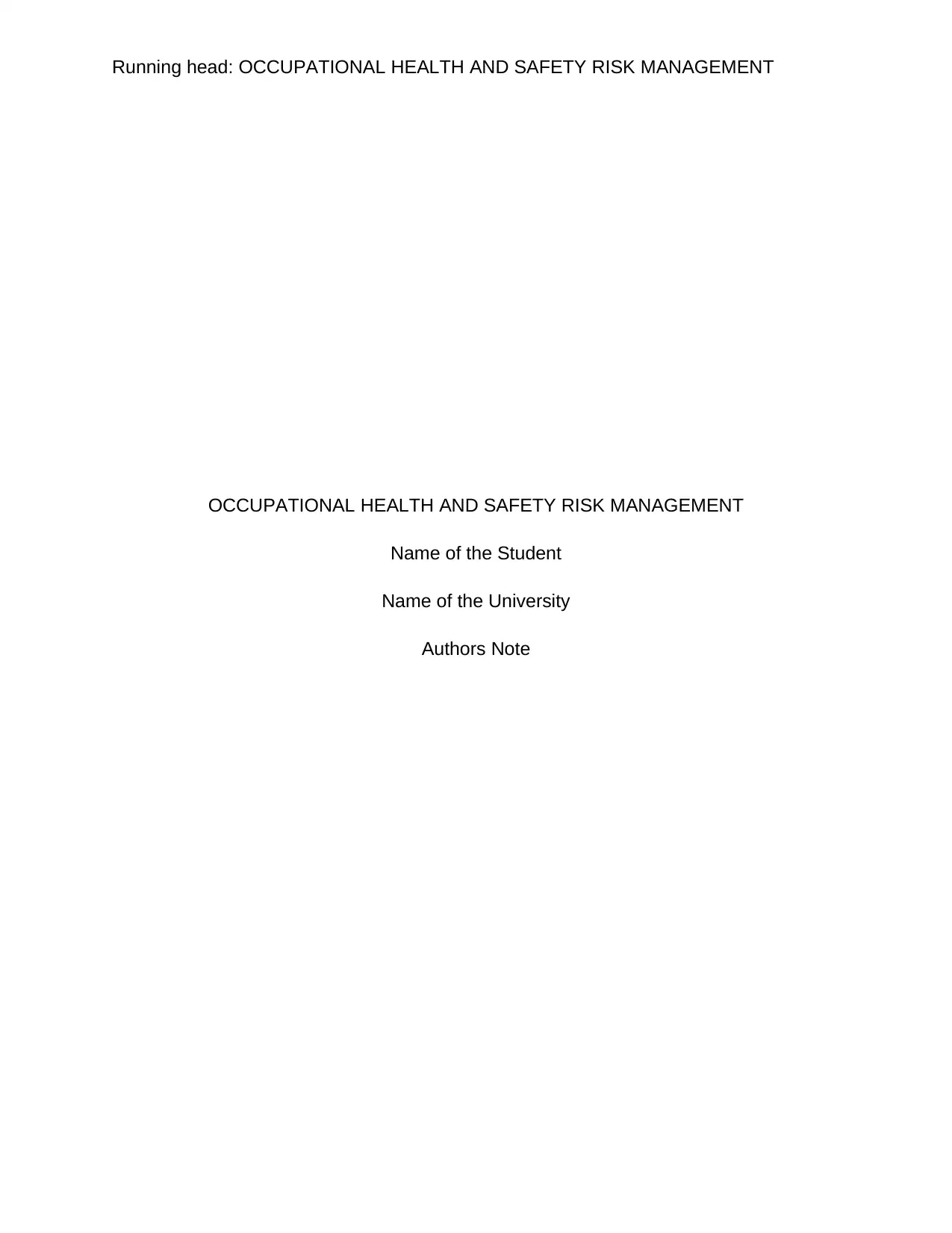
Running head: OCCUPATIONAL HEALTH AND SAFETY RISK MANAGEMENT
OCCUPATIONAL HEALTH AND SAFETY RISK MANAGEMENT
Name of the Student
Name of the University
Authors Note
OCCUPATIONAL HEALTH AND SAFETY RISK MANAGEMENT
Name of the Student
Name of the University
Authors Note
Paraphrase This Document
Need a fresh take? Get an instant paraphrase of this document with our AI Paraphraser
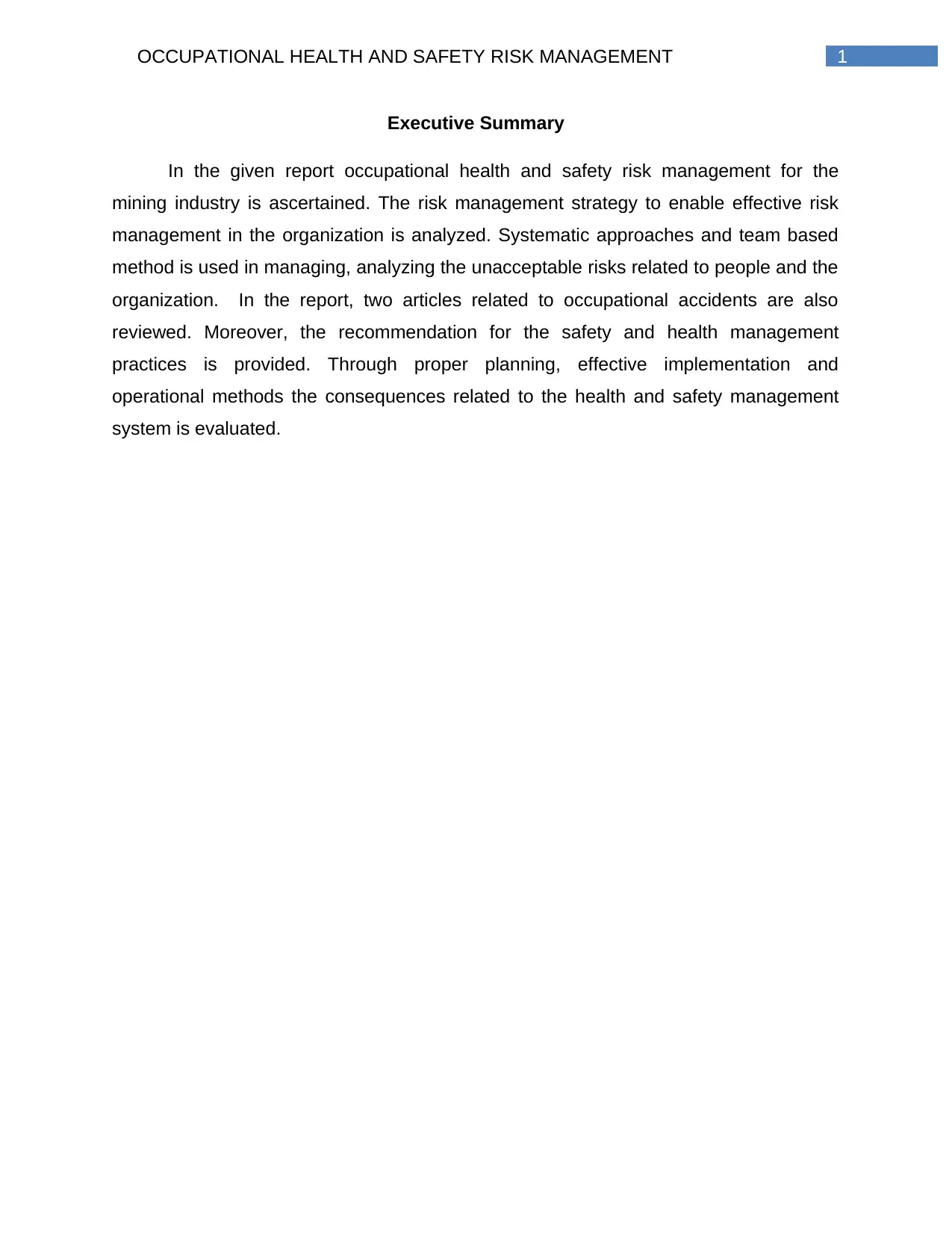
1OCCUPATIONAL HEALTH AND SAFETY RISK MANAGEMENT
Executive Summary
In the given report occupational health and safety risk management for the
mining industry is ascertained. The risk management strategy to enable effective risk
management in the organization is analyzed. Systematic approaches and team based
method is used in managing, analyzing the unacceptable risks related to people and the
organization. In the report, two articles related to occupational accidents are also
reviewed. Moreover, the recommendation for the safety and health management
practices is provided. Through proper planning, effective implementation and
operational methods the consequences related to the health and safety management
system is evaluated.
Executive Summary
In the given report occupational health and safety risk management for the
mining industry is ascertained. The risk management strategy to enable effective risk
management in the organization is analyzed. Systematic approaches and team based
method is used in managing, analyzing the unacceptable risks related to people and the
organization. In the report, two articles related to occupational accidents are also
reviewed. Moreover, the recommendation for the safety and health management
practices is provided. Through proper planning, effective implementation and
operational methods the consequences related to the health and safety management
system is evaluated.
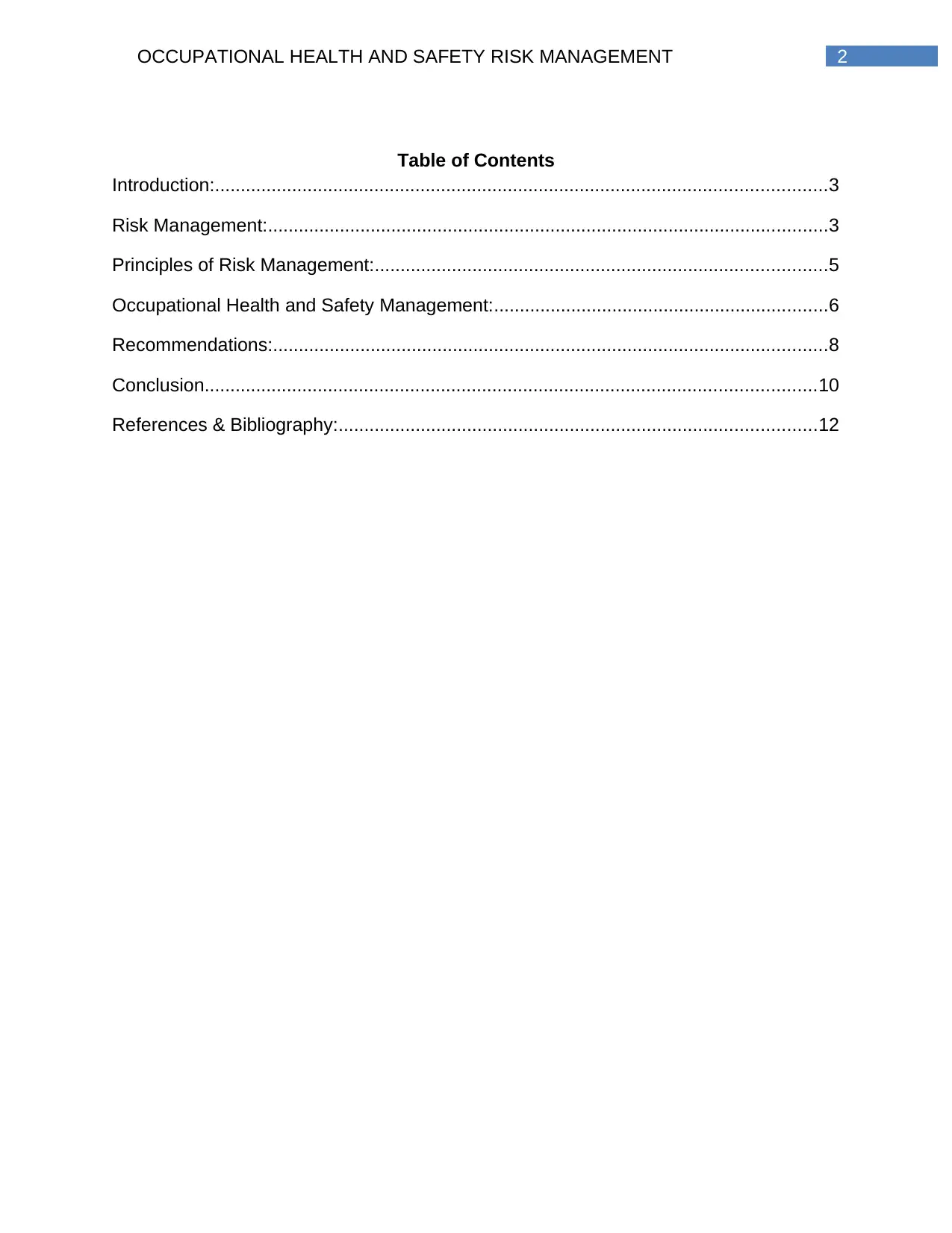
2OCCUPATIONAL HEALTH AND SAFETY RISK MANAGEMENT
Table of Contents
Introduction:.......................................................................................................................3
Risk Management:.............................................................................................................3
Principles of Risk Management:........................................................................................5
Occupational Health and Safety Management:.................................................................6
Recommendations:............................................................................................................8
Conclusion.......................................................................................................................10
References & Bibliography:.............................................................................................12
Table of Contents
Introduction:.......................................................................................................................3
Risk Management:.............................................................................................................3
Principles of Risk Management:........................................................................................5
Occupational Health and Safety Management:.................................................................6
Recommendations:............................................................................................................8
Conclusion.......................................................................................................................10
References & Bibliography:.............................................................................................12
⊘ This is a preview!⊘
Do you want full access?
Subscribe today to unlock all pages.

Trusted by 1+ million students worldwide
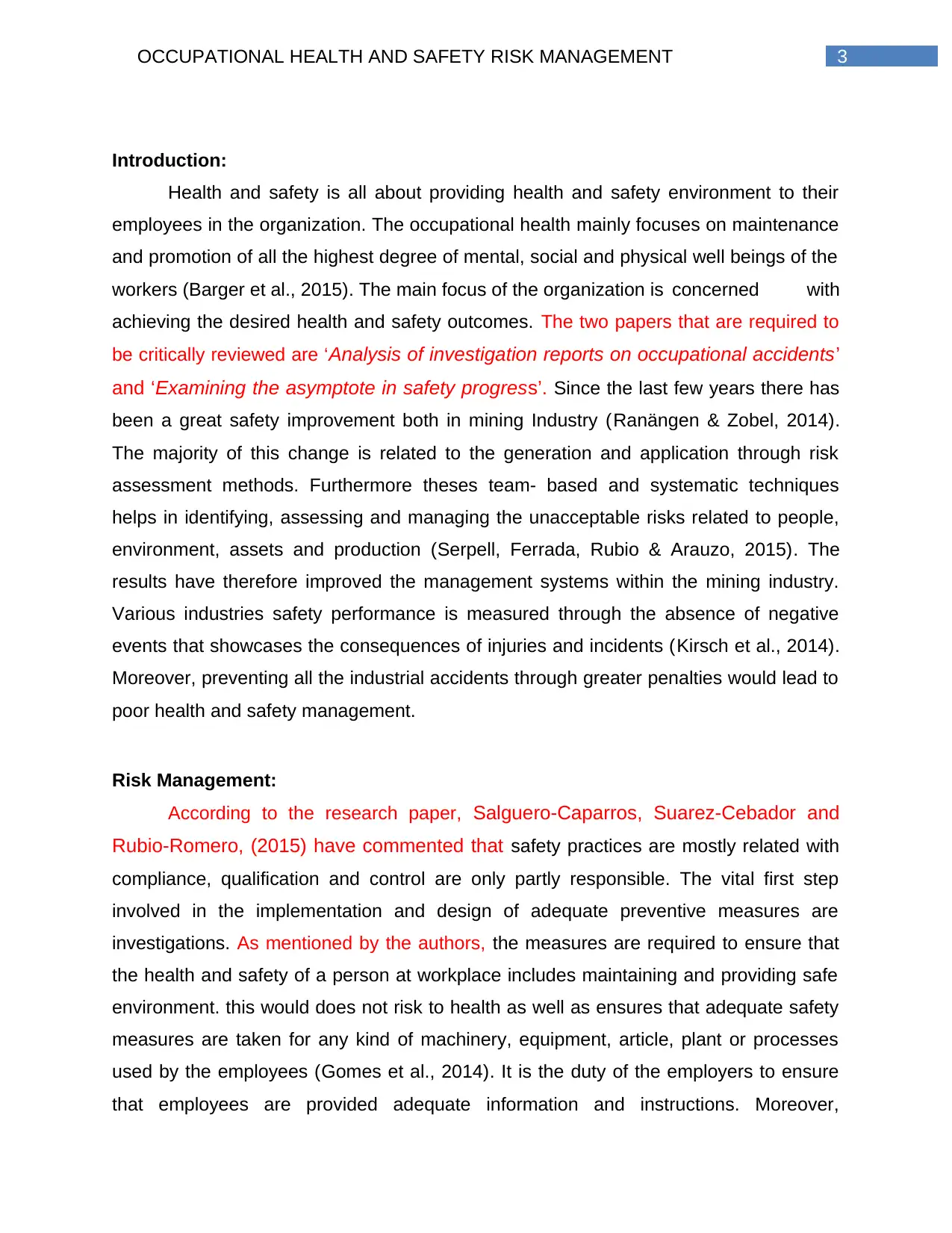
3OCCUPATIONAL HEALTH AND SAFETY RISK MANAGEMENT
Introduction:
Health and safety is all about providing health and safety environment to their
employees in the organization. The occupational health mainly focuses on maintenance
and promotion of all the highest degree of mental, social and physical well beings of the
workers (Barger et al., 2015). The main focus of the organization is concerned with
achieving the desired health and safety outcomes. The two papers that are required to
be critically reviewed are ‘Analysis of investigation reports on occupational accidents’
and ‘Examining the asymptote in safety progress’. Since the last few years there has
been a great safety improvement both in mining Industry (Ranängen & Zobel, 2014).
The majority of this change is related to the generation and application through risk
assessment methods. Furthermore theses team- based and systematic techniques
helps in identifying, assessing and managing the unacceptable risks related to people,
environment, assets and production (Serpell, Ferrada, Rubio & Arauzo, 2015). The
results have therefore improved the management systems within the mining industry.
Various industries safety performance is measured through the absence of negative
events that showcases the consequences of injuries and incidents (Kirsch et al., 2014).
Moreover, preventing all the industrial accidents through greater penalties would lead to
poor health and safety management.
Risk Management:
According to the research paper, Salguero-Caparros, Suarez-Cebador and
Rubio-Romero, (2015) have commented that safety practices are mostly related with
compliance, qualification and control are only partly responsible. The vital first step
involved in the implementation and design of adequate preventive measures are
investigations. As mentioned by the authors, the measures are required to ensure that
the health and safety of a person at workplace includes maintaining and providing safe
environment. this would does not risk to health as well as ensures that adequate safety
measures are taken for any kind of machinery, equipment, article, plant or processes
used by the employees (Gomes et al., 2014). It is the duty of the employers to ensure
that employees are provided adequate information and instructions. Moreover,
Introduction:
Health and safety is all about providing health and safety environment to their
employees in the organization. The occupational health mainly focuses on maintenance
and promotion of all the highest degree of mental, social and physical well beings of the
workers (Barger et al., 2015). The main focus of the organization is concerned with
achieving the desired health and safety outcomes. The two papers that are required to
be critically reviewed are ‘Analysis of investigation reports on occupational accidents’
and ‘Examining the asymptote in safety progress’. Since the last few years there has
been a great safety improvement both in mining Industry (Ranängen & Zobel, 2014).
The majority of this change is related to the generation and application through risk
assessment methods. Furthermore theses team- based and systematic techniques
helps in identifying, assessing and managing the unacceptable risks related to people,
environment, assets and production (Serpell, Ferrada, Rubio & Arauzo, 2015). The
results have therefore improved the management systems within the mining industry.
Various industries safety performance is measured through the absence of negative
events that showcases the consequences of injuries and incidents (Kirsch et al., 2014).
Moreover, preventing all the industrial accidents through greater penalties would lead to
poor health and safety management.
Risk Management:
According to the research paper, Salguero-Caparros, Suarez-Cebador and
Rubio-Romero, (2015) have commented that safety practices are mostly related with
compliance, qualification and control are only partly responsible. The vital first step
involved in the implementation and design of adequate preventive measures are
investigations. As mentioned by the authors, the measures are required to ensure that
the health and safety of a person at workplace includes maintaining and providing safe
environment. this would does not risk to health as well as ensures that adequate safety
measures are taken for any kind of machinery, equipment, article, plant or processes
used by the employees (Gomes et al., 2014). It is the duty of the employers to ensure
that employees are provided adequate information and instructions. Moreover,
Paraphrase This Document
Need a fresh take? Get an instant paraphrase of this document with our AI Paraphraser
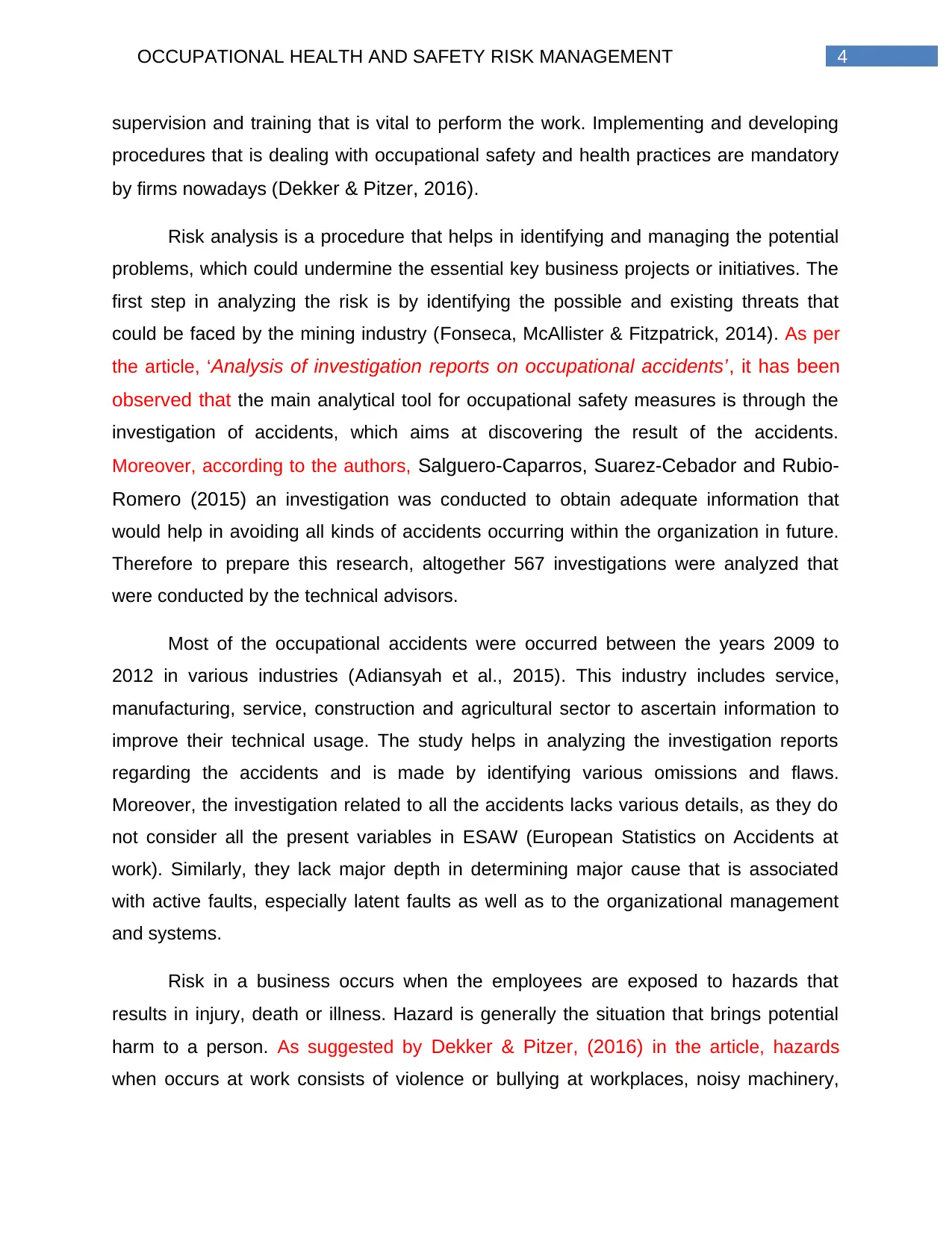
4OCCUPATIONAL HEALTH AND SAFETY RISK MANAGEMENT
supervision and training that is vital to perform the work. Implementing and developing
procedures that is dealing with occupational safety and health practices are mandatory
by firms nowadays (Dekker & Pitzer, 2016).
Risk analysis is a procedure that helps in identifying and managing the potential
problems, which could undermine the essential key business projects or initiatives. The
first step in analyzing the risk is by identifying the possible and existing threats that
could be faced by the mining industry (Fonseca, McAllister & Fitzpatrick, 2014). As per
the article, ‘Analysis of investigation reports on occupational accidents’, it has been
observed that the main analytical tool for occupational safety measures is through the
investigation of accidents, which aims at discovering the result of the accidents.
Moreover, according to the authors, Salguero-Caparros, Suarez-Cebador and Rubio-
Romero (2015) an investigation was conducted to obtain adequate information that
would help in avoiding all kinds of accidents occurring within the organization in future.
Therefore to prepare this research, altogether 567 investigations were analyzed that
were conducted by the technical advisors.
Most of the occupational accidents were occurred between the years 2009 to
2012 in various industries (Adiansyah et al., 2015). This industry includes service,
manufacturing, service, construction and agricultural sector to ascertain information to
improve their technical usage. The study helps in analyzing the investigation reports
regarding the accidents and is made by identifying various omissions and flaws.
Moreover, the investigation related to all the accidents lacks various details, as they do
not consider all the present variables in ESAW (European Statistics on Accidents at
work). Similarly, they lack major depth in determining major cause that is associated
with active faults, especially latent faults as well as to the organizational management
and systems.
Risk in a business occurs when the employees are exposed to hazards that
results in injury, death or illness. Hazard is generally the situation that brings potential
harm to a person. As suggested by Dekker & Pitzer, (2016) in the article, hazards
when occurs at work consists of violence or bullying at workplaces, noisy machinery,
supervision and training that is vital to perform the work. Implementing and developing
procedures that is dealing with occupational safety and health practices are mandatory
by firms nowadays (Dekker & Pitzer, 2016).
Risk analysis is a procedure that helps in identifying and managing the potential
problems, which could undermine the essential key business projects or initiatives. The
first step in analyzing the risk is by identifying the possible and existing threats that
could be faced by the mining industry (Fonseca, McAllister & Fitzpatrick, 2014). As per
the article, ‘Analysis of investigation reports on occupational accidents’, it has been
observed that the main analytical tool for occupational safety measures is through the
investigation of accidents, which aims at discovering the result of the accidents.
Moreover, according to the authors, Salguero-Caparros, Suarez-Cebador and Rubio-
Romero (2015) an investigation was conducted to obtain adequate information that
would help in avoiding all kinds of accidents occurring within the organization in future.
Therefore to prepare this research, altogether 567 investigations were analyzed that
were conducted by the technical advisors.
Most of the occupational accidents were occurred between the years 2009 to
2012 in various industries (Adiansyah et al., 2015). This industry includes service,
manufacturing, service, construction and agricultural sector to ascertain information to
improve their technical usage. The study helps in analyzing the investigation reports
regarding the accidents and is made by identifying various omissions and flaws.
Moreover, the investigation related to all the accidents lacks various details, as they do
not consider all the present variables in ESAW (European Statistics on Accidents at
work). Similarly, they lack major depth in determining major cause that is associated
with active faults, especially latent faults as well as to the organizational management
and systems.
Risk in a business occurs when the employees are exposed to hazards that
results in injury, death or illness. Hazard is generally the situation that brings potential
harm to a person. As suggested by Dekker & Pitzer, (2016) in the article, hazards
when occurs at work consists of violence or bullying at workplaces, noisy machinery,
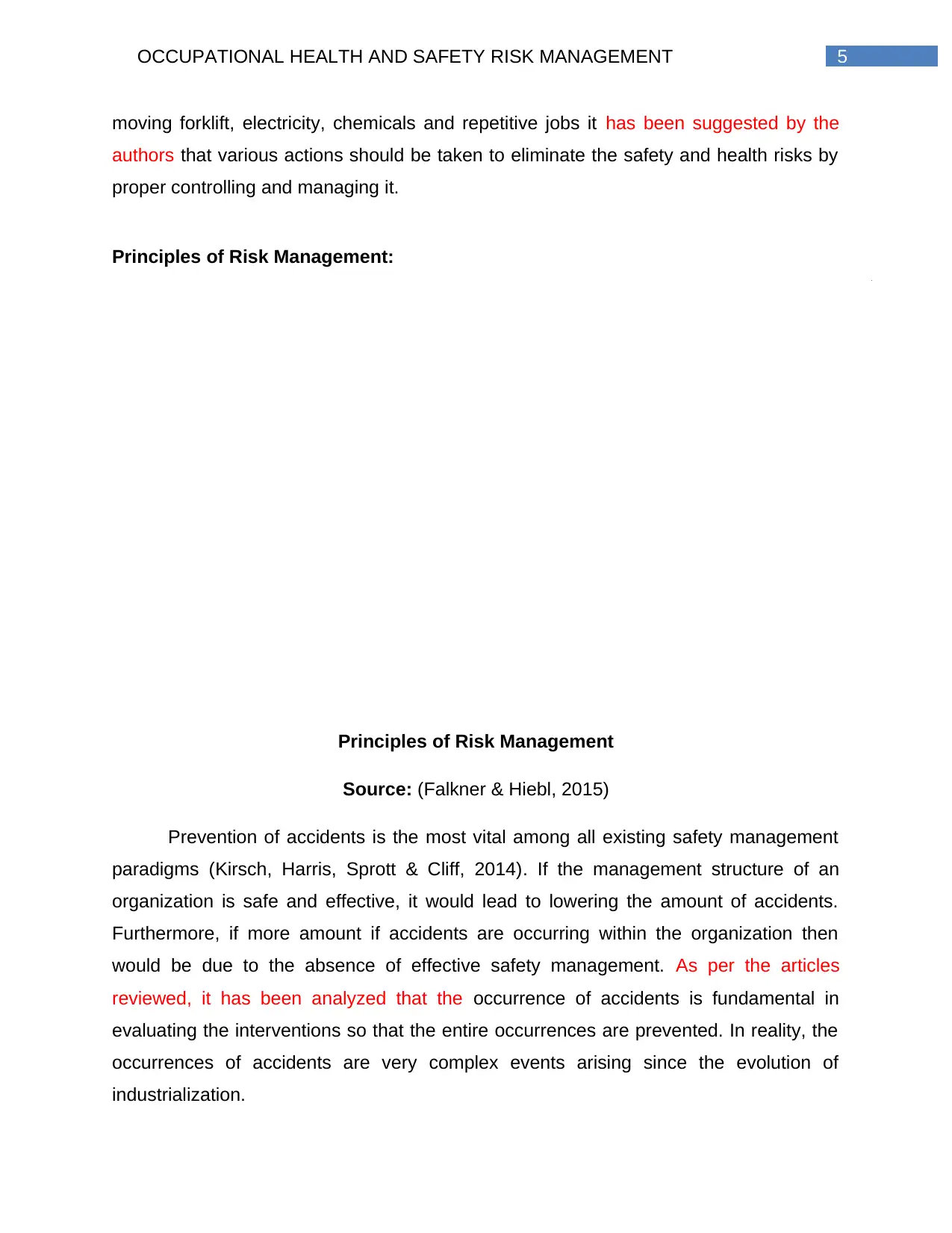
5OCCUPATIONAL HEALTH AND SAFETY RISK MANAGEMENT
moving forklift, electricity, chemicals and repetitive jobs it has been suggested by the
authors that various actions should be taken to eliminate the safety and health risks by
proper controlling and managing it.
Principles of Risk Management:
Principles of Risk Management
Source: (Falkner & Hiebl, 2015)
Prevention of accidents is the most vital among all existing safety management
paradigms (Kirsch, Harris, Sprott & Cliff, 2014). If the management structure of an
organization is safe and effective, it would lead to lowering the amount of accidents.
Furthermore, if more amount if accidents are occurring within the organization then
would be due to the absence of effective safety management. As per the articles
reviewed, it has been analyzed that the occurrence of accidents is fundamental in
evaluating the interventions so that the entire occurrences are prevented. In reality, the
occurrences of accidents are very complex events arising since the evolution of
industrialization.
moving forklift, electricity, chemicals and repetitive jobs it has been suggested by the
authors that various actions should be taken to eliminate the safety and health risks by
proper controlling and managing it.
Principles of Risk Management:
Principles of Risk Management
Source: (Falkner & Hiebl, 2015)
Prevention of accidents is the most vital among all existing safety management
paradigms (Kirsch, Harris, Sprott & Cliff, 2014). If the management structure of an
organization is safe and effective, it would lead to lowering the amount of accidents.
Furthermore, if more amount if accidents are occurring within the organization then
would be due to the absence of effective safety management. As per the articles
reviewed, it has been analyzed that the occurrence of accidents is fundamental in
evaluating the interventions so that the entire occurrences are prevented. In reality, the
occurrences of accidents are very complex events arising since the evolution of
industrialization.
⊘ This is a preview!⊘
Do you want full access?
Subscribe today to unlock all pages.

Trusted by 1+ million students worldwide
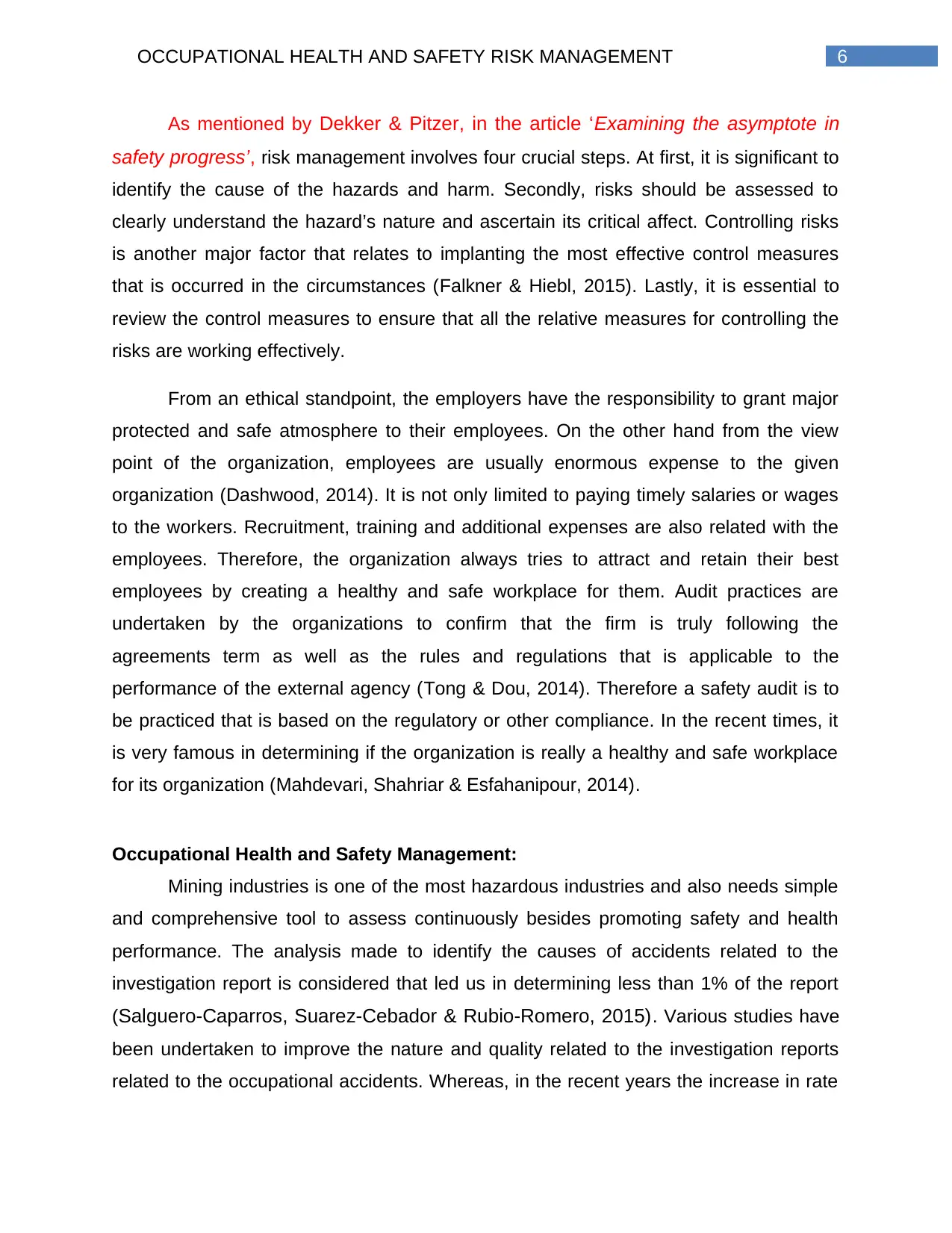
6OCCUPATIONAL HEALTH AND SAFETY RISK MANAGEMENT
As mentioned by Dekker & Pitzer, in the article ‘Examining the asymptote in
safety progress’, risk management involves four crucial steps. At first, it is significant to
identify the cause of the hazards and harm. Secondly, risks should be assessed to
clearly understand the hazard’s nature and ascertain its critical affect. Controlling risks
is another major factor that relates to implanting the most effective control measures
that is occurred in the circumstances (Falkner & Hiebl, 2015). Lastly, it is essential to
review the control measures to ensure that all the relative measures for controlling the
risks are working effectively.
From an ethical standpoint, the employers have the responsibility to grant major
protected and safe atmosphere to their employees. On the other hand from the view
point of the organization, employees are usually enormous expense to the given
organization (Dashwood, 2014). It is not only limited to paying timely salaries or wages
to the workers. Recruitment, training and additional expenses are also related with the
employees. Therefore, the organization always tries to attract and retain their best
employees by creating a healthy and safe workplace for them. Audit practices are
undertaken by the organizations to confirm that the firm is truly following the
agreements term as well as the rules and regulations that is applicable to the
performance of the external agency (Tong & Dou, 2014). Therefore a safety audit is to
be practiced that is based on the regulatory or other compliance. In the recent times, it
is very famous in determining if the organization is really a healthy and safe workplace
for its organization (Mahdevari, Shahriar & Esfahanipour, 2014).
Occupational Health and Safety Management:
Mining industries is one of the most hazardous industries and also needs simple
and comprehensive tool to assess continuously besides promoting safety and health
performance. The analysis made to identify the causes of accidents related to the
investigation report is considered that led us in determining less than 1% of the report
(Salguero-Caparros, Suarez-Cebador & Rubio-Romero, 2015). Various studies have
been undertaken to improve the nature and quality related to the investigation reports
related to the occupational accidents. Whereas, in the recent years the increase in rate
As mentioned by Dekker & Pitzer, in the article ‘Examining the asymptote in
safety progress’, risk management involves four crucial steps. At first, it is significant to
identify the cause of the hazards and harm. Secondly, risks should be assessed to
clearly understand the hazard’s nature and ascertain its critical affect. Controlling risks
is another major factor that relates to implanting the most effective control measures
that is occurred in the circumstances (Falkner & Hiebl, 2015). Lastly, it is essential to
review the control measures to ensure that all the relative measures for controlling the
risks are working effectively.
From an ethical standpoint, the employers have the responsibility to grant major
protected and safe atmosphere to their employees. On the other hand from the view
point of the organization, employees are usually enormous expense to the given
organization (Dashwood, 2014). It is not only limited to paying timely salaries or wages
to the workers. Recruitment, training and additional expenses are also related with the
employees. Therefore, the organization always tries to attract and retain their best
employees by creating a healthy and safe workplace for them. Audit practices are
undertaken by the organizations to confirm that the firm is truly following the
agreements term as well as the rules and regulations that is applicable to the
performance of the external agency (Tong & Dou, 2014). Therefore a safety audit is to
be practiced that is based on the regulatory or other compliance. In the recent times, it
is very famous in determining if the organization is really a healthy and safe workplace
for its organization (Mahdevari, Shahriar & Esfahanipour, 2014).
Occupational Health and Safety Management:
Mining industries is one of the most hazardous industries and also needs simple
and comprehensive tool to assess continuously besides promoting safety and health
performance. The analysis made to identify the causes of accidents related to the
investigation report is considered that led us in determining less than 1% of the report
(Salguero-Caparros, Suarez-Cebador & Rubio-Romero, 2015). Various studies have
been undertaken to improve the nature and quality related to the investigation reports
related to the occupational accidents. Whereas, in the recent years the increase in rate
Paraphrase This Document
Need a fresh take? Get an instant paraphrase of this document with our AI Paraphraser
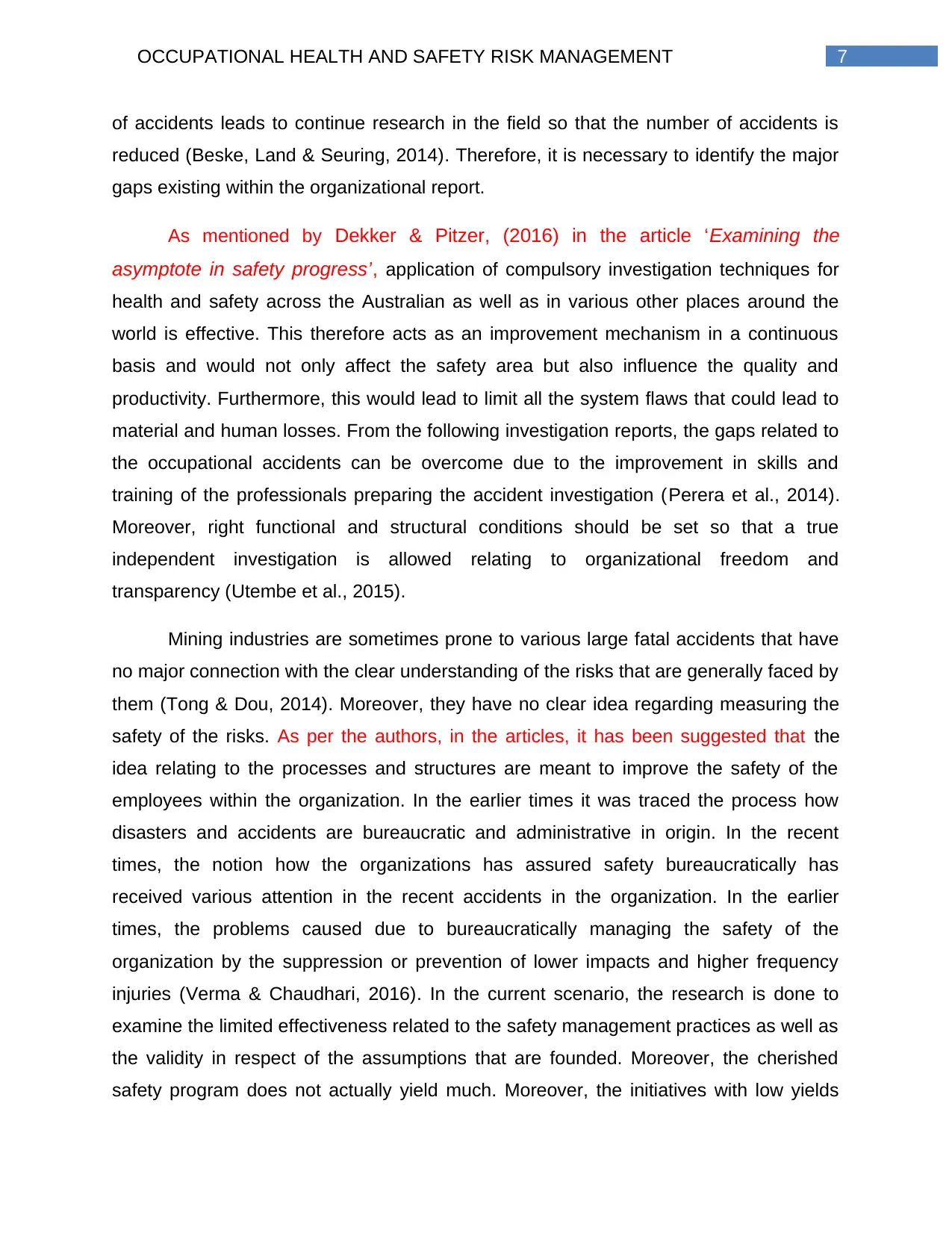
7OCCUPATIONAL HEALTH AND SAFETY RISK MANAGEMENT
of accidents leads to continue research in the field so that the number of accidents is
reduced (Beske, Land & Seuring, 2014). Therefore, it is necessary to identify the major
gaps existing within the organizational report.
As mentioned by Dekker & Pitzer, (2016) in the article ‘Examining the
asymptote in safety progress’, application of compulsory investigation techniques for
health and safety across the Australian as well as in various other places around the
world is effective. This therefore acts as an improvement mechanism in a continuous
basis and would not only affect the safety area but also influence the quality and
productivity. Furthermore, this would lead to limit all the system flaws that could lead to
material and human losses. From the following investigation reports, the gaps related to
the occupational accidents can be overcome due to the improvement in skills and
training of the professionals preparing the accident investigation (Perera et al., 2014).
Moreover, right functional and structural conditions should be set so that a true
independent investigation is allowed relating to organizational freedom and
transparency (Utembe et al., 2015).
Mining industries are sometimes prone to various large fatal accidents that have
no major connection with the clear understanding of the risks that are generally faced by
them (Tong & Dou, 2014). Moreover, they have no clear idea regarding measuring the
safety of the risks. As per the authors, in the articles, it has been suggested that the
idea relating to the processes and structures are meant to improve the safety of the
employees within the organization. In the earlier times it was traced the process how
disasters and accidents are bureaucratic and administrative in origin. In the recent
times, the notion how the organizations has assured safety bureaucratically has
received various attention in the recent accidents in the organization. In the earlier
times, the problems caused due to bureaucratically managing the safety of the
organization by the suppression or prevention of lower impacts and higher frequency
injuries (Verma & Chaudhari, 2016). In the current scenario, the research is done to
examine the limited effectiveness related to the safety management practices as well as
the validity in respect of the assumptions that are founded. Moreover, the cherished
safety program does not actually yield much. Moreover, the initiatives with low yields
of accidents leads to continue research in the field so that the number of accidents is
reduced (Beske, Land & Seuring, 2014). Therefore, it is necessary to identify the major
gaps existing within the organizational report.
As mentioned by Dekker & Pitzer, (2016) in the article ‘Examining the
asymptote in safety progress’, application of compulsory investigation techniques for
health and safety across the Australian as well as in various other places around the
world is effective. This therefore acts as an improvement mechanism in a continuous
basis and would not only affect the safety area but also influence the quality and
productivity. Furthermore, this would lead to limit all the system flaws that could lead to
material and human losses. From the following investigation reports, the gaps related to
the occupational accidents can be overcome due to the improvement in skills and
training of the professionals preparing the accident investigation (Perera et al., 2014).
Moreover, right functional and structural conditions should be set so that a true
independent investigation is allowed relating to organizational freedom and
transparency (Utembe et al., 2015).
Mining industries are sometimes prone to various large fatal accidents that have
no major connection with the clear understanding of the risks that are generally faced by
them (Tong & Dou, 2014). Moreover, they have no clear idea regarding measuring the
safety of the risks. As per the authors, in the articles, it has been suggested that the
idea relating to the processes and structures are meant to improve the safety of the
employees within the organization. In the earlier times it was traced the process how
disasters and accidents are bureaucratic and administrative in origin. In the recent
times, the notion how the organizations has assured safety bureaucratically has
received various attention in the recent accidents in the organization. In the earlier
times, the problems caused due to bureaucratically managing the safety of the
organization by the suppression or prevention of lower impacts and higher frequency
injuries (Verma & Chaudhari, 2016). In the current scenario, the research is done to
examine the limited effectiveness related to the safety management practices as well as
the validity in respect of the assumptions that are founded. Moreover, the cherished
safety program does not actually yield much. Moreover, the initiatives with low yields
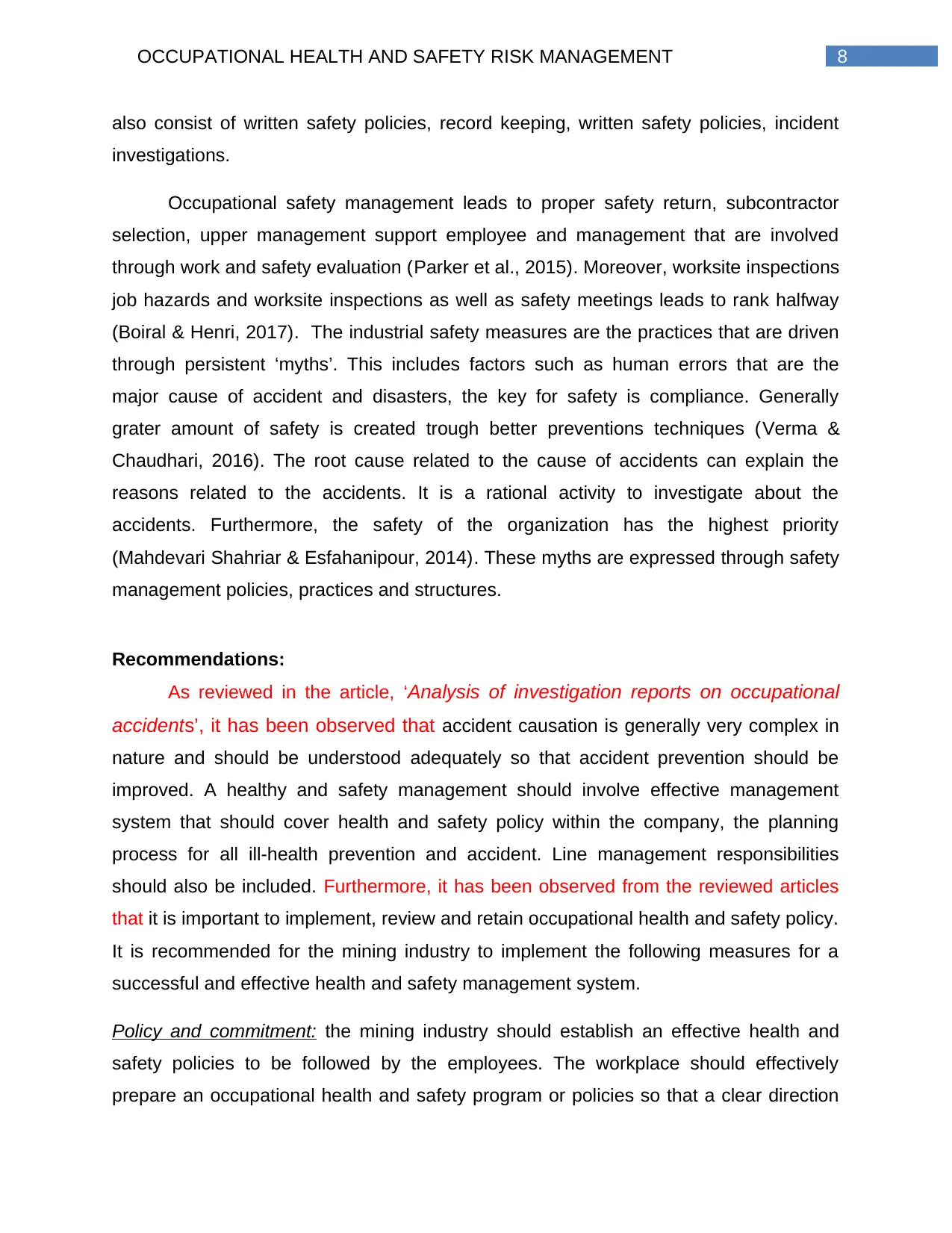
8OCCUPATIONAL HEALTH AND SAFETY RISK MANAGEMENT
also consist of written safety policies, record keeping, written safety policies, incident
investigations.
Occupational safety management leads to proper safety return, subcontractor
selection, upper management support employee and management that are involved
through work and safety evaluation (Parker et al., 2015). Moreover, worksite inspections
job hazards and worksite inspections as well as safety meetings leads to rank halfway
(Boiral & Henri, 2017). The industrial safety measures are the practices that are driven
through persistent ‘myths’. This includes factors such as human errors that are the
major cause of accident and disasters, the key for safety is compliance. Generally
grater amount of safety is created trough better preventions techniques (Verma &
Chaudhari, 2016). The root cause related to the cause of accidents can explain the
reasons related to the accidents. It is a rational activity to investigate about the
accidents. Furthermore, the safety of the organization has the highest priority
(Mahdevari Shahriar & Esfahanipour, 2014). These myths are expressed through safety
management policies, practices and structures.
Recommendations:
As reviewed in the article, ‘Analysis of investigation reports on occupational
accidents’, it has been observed that accident causation is generally very complex in
nature and should be understood adequately so that accident prevention should be
improved. A healthy and safety management should involve effective management
system that should cover health and safety policy within the company, the planning
process for all ill-health prevention and accident. Line management responsibilities
should also be included. Furthermore, it has been observed from the reviewed articles
that it is important to implement, review and retain occupational health and safety policy.
It is recommended for the mining industry to implement the following measures for a
successful and effective health and safety management system.
Policy and commitment: the mining industry should establish an effective health and
safety policies to be followed by the employees. The workplace should effectively
prepare an occupational health and safety program or policies so that a clear direction
also consist of written safety policies, record keeping, written safety policies, incident
investigations.
Occupational safety management leads to proper safety return, subcontractor
selection, upper management support employee and management that are involved
through work and safety evaluation (Parker et al., 2015). Moreover, worksite inspections
job hazards and worksite inspections as well as safety meetings leads to rank halfway
(Boiral & Henri, 2017). The industrial safety measures are the practices that are driven
through persistent ‘myths’. This includes factors such as human errors that are the
major cause of accident and disasters, the key for safety is compliance. Generally
grater amount of safety is created trough better preventions techniques (Verma &
Chaudhari, 2016). The root cause related to the cause of accidents can explain the
reasons related to the accidents. It is a rational activity to investigate about the
accidents. Furthermore, the safety of the organization has the highest priority
(Mahdevari Shahriar & Esfahanipour, 2014). These myths are expressed through safety
management policies, practices and structures.
Recommendations:
As reviewed in the article, ‘Analysis of investigation reports on occupational
accidents’, it has been observed that accident causation is generally very complex in
nature and should be understood adequately so that accident prevention should be
improved. A healthy and safety management should involve effective management
system that should cover health and safety policy within the company, the planning
process for all ill-health prevention and accident. Line management responsibilities
should also be included. Furthermore, it has been observed from the reviewed articles
that it is important to implement, review and retain occupational health and safety policy.
It is recommended for the mining industry to implement the following measures for a
successful and effective health and safety management system.
Policy and commitment: the mining industry should establish an effective health and
safety policies to be followed by the employees. The workplace should effectively
prepare an occupational health and safety program or policies so that a clear direction
⊘ This is a preview!⊘
Do you want full access?
Subscribe today to unlock all pages.

Trusted by 1+ million students worldwide
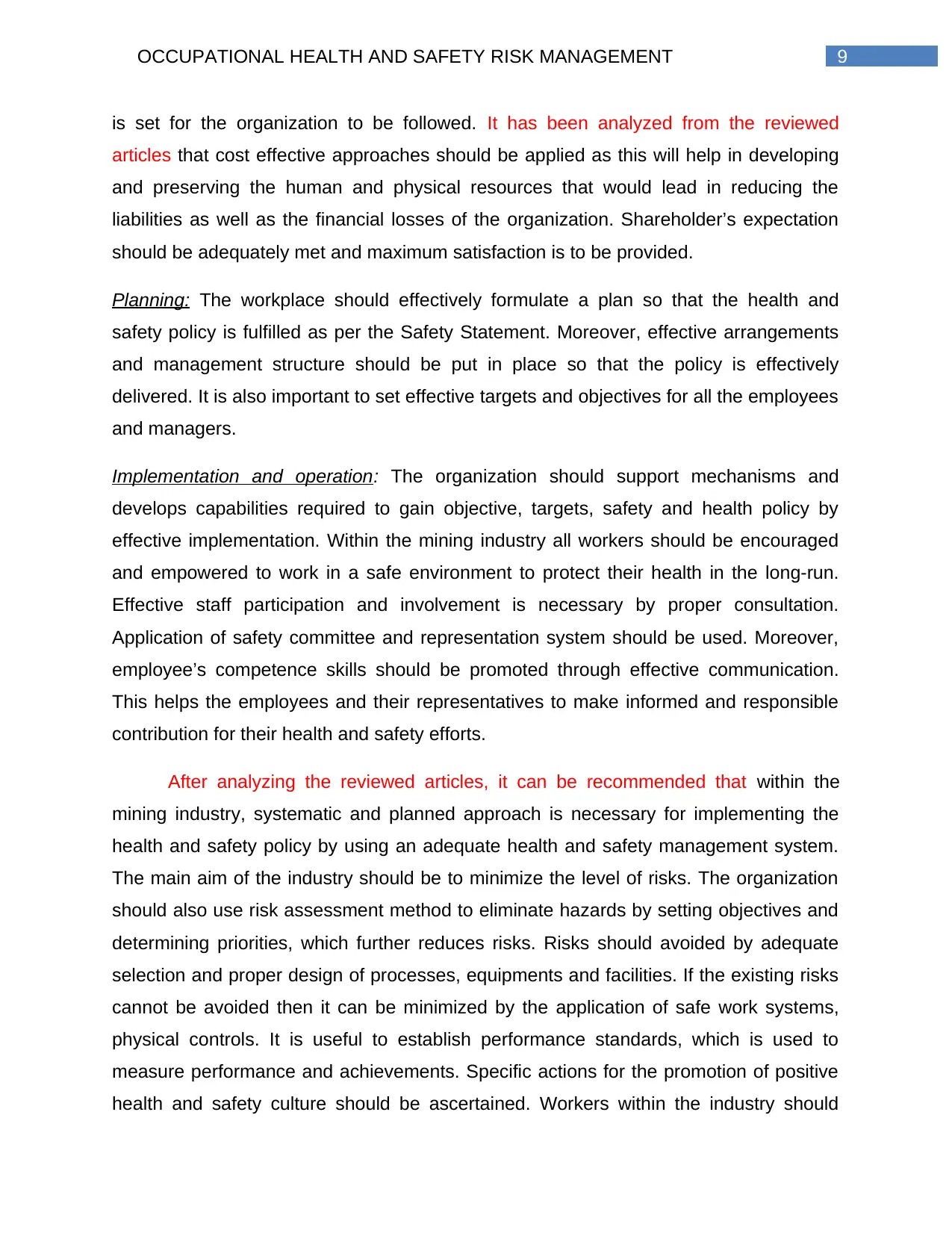
9OCCUPATIONAL HEALTH AND SAFETY RISK MANAGEMENT
is set for the organization to be followed. It has been analyzed from the reviewed
articles that cost effective approaches should be applied as this will help in developing
and preserving the human and physical resources that would lead in reducing the
liabilities as well as the financial losses of the organization. Shareholder’s expectation
should be adequately met and maximum satisfaction is to be provided.
Planning: The workplace should effectively formulate a plan so that the health and
safety policy is fulfilled as per the Safety Statement. Moreover, effective arrangements
and management structure should be put in place so that the policy is effectively
delivered. It is also important to set effective targets and objectives for all the employees
and managers.
Implementation and operation: The organization should support mechanisms and
develops capabilities required to gain objective, targets, safety and health policy by
effective implementation. Within the mining industry all workers should be encouraged
and empowered to work in a safe environment to protect their health in the long-run.
Effective staff participation and involvement is necessary by proper consultation.
Application of safety committee and representation system should be used. Moreover,
employee’s competence skills should be promoted through effective communication.
This helps the employees and their representatives to make informed and responsible
contribution for their health and safety efforts.
After analyzing the reviewed articles, it can be recommended that within the
mining industry, systematic and planned approach is necessary for implementing the
health and safety policy by using an adequate health and safety management system.
The main aim of the industry should be to minimize the level of risks. The organization
should also use risk assessment method to eliminate hazards by setting objectives and
determining priorities, which further reduces risks. Risks should avoided by adequate
selection and proper design of processes, equipments and facilities. If the existing risks
cannot be avoided then it can be minimized by the application of safe work systems,
physical controls. It is useful to establish performance standards, which is used to
measure performance and achievements. Specific actions for the promotion of positive
health and safety culture should be ascertained. Workers within the industry should
is set for the organization to be followed. It has been analyzed from the reviewed
articles that cost effective approaches should be applied as this will help in developing
and preserving the human and physical resources that would lead in reducing the
liabilities as well as the financial losses of the organization. Shareholder’s expectation
should be adequately met and maximum satisfaction is to be provided.
Planning: The workplace should effectively formulate a plan so that the health and
safety policy is fulfilled as per the Safety Statement. Moreover, effective arrangements
and management structure should be put in place so that the policy is effectively
delivered. It is also important to set effective targets and objectives for all the employees
and managers.
Implementation and operation: The organization should support mechanisms and
develops capabilities required to gain objective, targets, safety and health policy by
effective implementation. Within the mining industry all workers should be encouraged
and empowered to work in a safe environment to protect their health in the long-run.
Effective staff participation and involvement is necessary by proper consultation.
Application of safety committee and representation system should be used. Moreover,
employee’s competence skills should be promoted through effective communication.
This helps the employees and their representatives to make informed and responsible
contribution for their health and safety efforts.
After analyzing the reviewed articles, it can be recommended that within the
mining industry, systematic and planned approach is necessary for implementing the
health and safety policy by using an adequate health and safety management system.
The main aim of the industry should be to minimize the level of risks. The organization
should also use risk assessment method to eliminate hazards by setting objectives and
determining priorities, which further reduces risks. Risks should avoided by adequate
selection and proper design of processes, equipments and facilities. If the existing risks
cannot be avoided then it can be minimized by the application of safe work systems,
physical controls. It is useful to establish performance standards, which is used to
measure performance and achievements. Specific actions for the promotion of positive
health and safety culture should be ascertained. Workers within the industry should
Paraphrase This Document
Need a fresh take? Get an instant paraphrase of this document with our AI Paraphraser
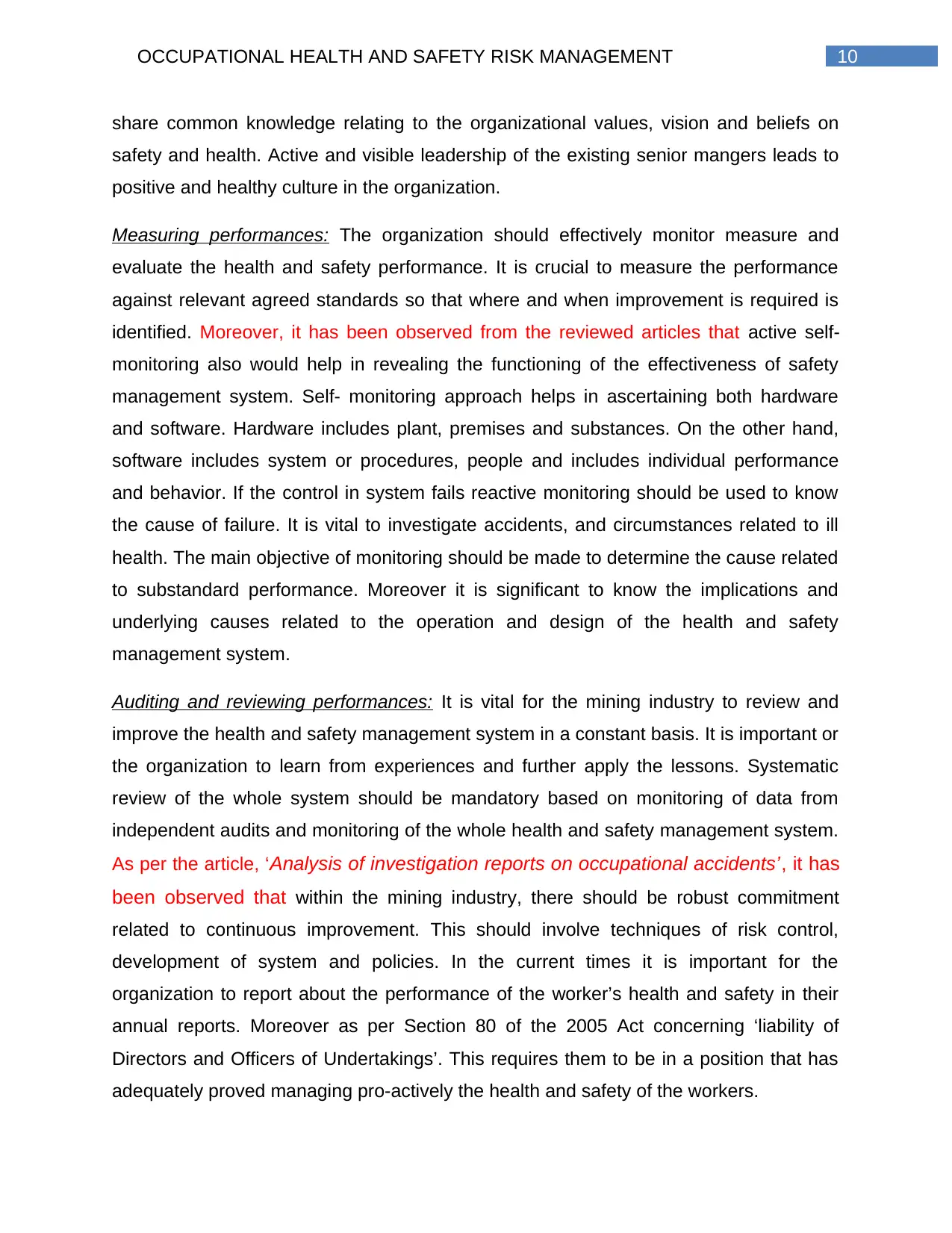
10OCCUPATIONAL HEALTH AND SAFETY RISK MANAGEMENT
share common knowledge relating to the organizational values, vision and beliefs on
safety and health. Active and visible leadership of the existing senior mangers leads to
positive and healthy culture in the organization.
Measuring performances: The organization should effectively monitor measure and
evaluate the health and safety performance. It is crucial to measure the performance
against relevant agreed standards so that where and when improvement is required is
identified. Moreover, it has been observed from the reviewed articles that active self-
monitoring also would help in revealing the functioning of the effectiveness of safety
management system. Self- monitoring approach helps in ascertaining both hardware
and software. Hardware includes plant, premises and substances. On the other hand,
software includes system or procedures, people and includes individual performance
and behavior. If the control in system fails reactive monitoring should be used to know
the cause of failure. It is vital to investigate accidents, and circumstances related to ill
health. The main objective of monitoring should be made to determine the cause related
to substandard performance. Moreover it is significant to know the implications and
underlying causes related to the operation and design of the health and safety
management system.
Auditing and reviewing performances: It is vital for the mining industry to review and
improve the health and safety management system in a constant basis. It is important or
the organization to learn from experiences and further apply the lessons. Systematic
review of the whole system should be mandatory based on monitoring of data from
independent audits and monitoring of the whole health and safety management system.
As per the article, ‘Analysis of investigation reports on occupational accidents’, it has
been observed that within the mining industry, there should be robust commitment
related to continuous improvement. This should involve techniques of risk control,
development of system and policies. In the current times it is important for the
organization to report about the performance of the worker’s health and safety in their
annual reports. Moreover as per Section 80 of the 2005 Act concerning ‘liability of
Directors and Officers of Undertakings’. This requires them to be in a position that has
adequately proved managing pro-actively the health and safety of the workers.
share common knowledge relating to the organizational values, vision and beliefs on
safety and health. Active and visible leadership of the existing senior mangers leads to
positive and healthy culture in the organization.
Measuring performances: The organization should effectively monitor measure and
evaluate the health and safety performance. It is crucial to measure the performance
against relevant agreed standards so that where and when improvement is required is
identified. Moreover, it has been observed from the reviewed articles that active self-
monitoring also would help in revealing the functioning of the effectiveness of safety
management system. Self- monitoring approach helps in ascertaining both hardware
and software. Hardware includes plant, premises and substances. On the other hand,
software includes system or procedures, people and includes individual performance
and behavior. If the control in system fails reactive monitoring should be used to know
the cause of failure. It is vital to investigate accidents, and circumstances related to ill
health. The main objective of monitoring should be made to determine the cause related
to substandard performance. Moreover it is significant to know the implications and
underlying causes related to the operation and design of the health and safety
management system.
Auditing and reviewing performances: It is vital for the mining industry to review and
improve the health and safety management system in a constant basis. It is important or
the organization to learn from experiences and further apply the lessons. Systematic
review of the whole system should be mandatory based on monitoring of data from
independent audits and monitoring of the whole health and safety management system.
As per the article, ‘Analysis of investigation reports on occupational accidents’, it has
been observed that within the mining industry, there should be robust commitment
related to continuous improvement. This should involve techniques of risk control,
development of system and policies. In the current times it is important for the
organization to report about the performance of the worker’s health and safety in their
annual reports. Moreover as per Section 80 of the 2005 Act concerning ‘liability of
Directors and Officers of Undertakings’. This requires them to be in a position that has
adequately proved managing pro-actively the health and safety of the workers.
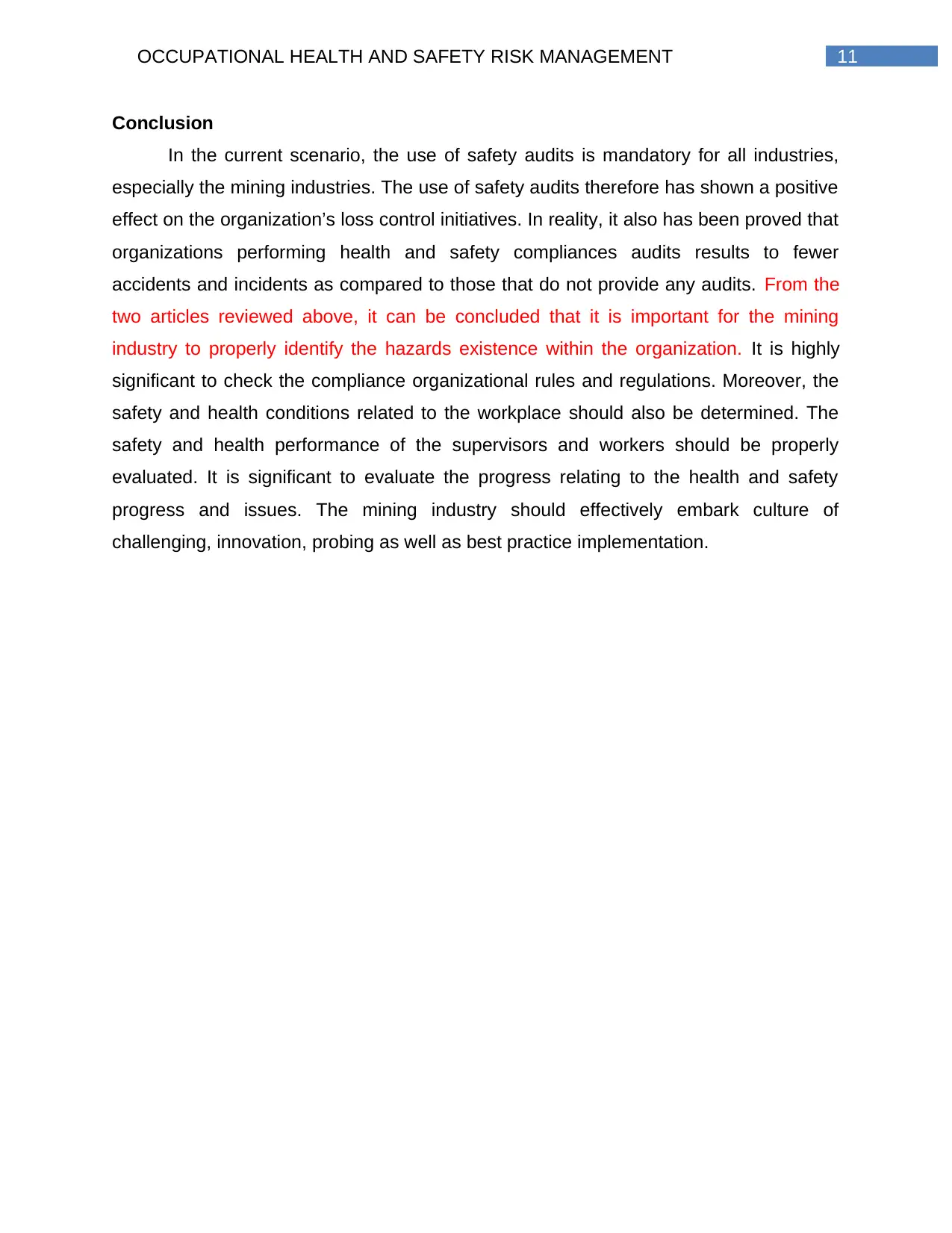
11OCCUPATIONAL HEALTH AND SAFETY RISK MANAGEMENT
Conclusion
In the current scenario, the use of safety audits is mandatory for all industries,
especially the mining industries. The use of safety audits therefore has shown a positive
effect on the organization’s loss control initiatives. In reality, it also has been proved that
organizations performing health and safety compliances audits results to fewer
accidents and incidents as compared to those that do not provide any audits. From the
two articles reviewed above, it can be concluded that it is important for the mining
industry to properly identify the hazards existence within the organization. It is highly
significant to check the compliance organizational rules and regulations. Moreover, the
safety and health conditions related to the workplace should also be determined. The
safety and health performance of the supervisors and workers should be properly
evaluated. It is significant to evaluate the progress relating to the health and safety
progress and issues. The mining industry should effectively embark culture of
challenging, innovation, probing as well as best practice implementation.
Conclusion
In the current scenario, the use of safety audits is mandatory for all industries,
especially the mining industries. The use of safety audits therefore has shown a positive
effect on the organization’s loss control initiatives. In reality, it also has been proved that
organizations performing health and safety compliances audits results to fewer
accidents and incidents as compared to those that do not provide any audits. From the
two articles reviewed above, it can be concluded that it is important for the mining
industry to properly identify the hazards existence within the organization. It is highly
significant to check the compliance organizational rules and regulations. Moreover, the
safety and health conditions related to the workplace should also be determined. The
safety and health performance of the supervisors and workers should be properly
evaluated. It is significant to evaluate the progress relating to the health and safety
progress and issues. The mining industry should effectively embark culture of
challenging, innovation, probing as well as best practice implementation.
⊘ This is a preview!⊘
Do you want full access?
Subscribe today to unlock all pages.

Trusted by 1+ million students worldwide
1 out of 16
Related Documents
Your All-in-One AI-Powered Toolkit for Academic Success.
+13062052269
info@desklib.com
Available 24*7 on WhatsApp / Email
![[object Object]](/_next/static/media/star-bottom.7253800d.svg)
Unlock your academic potential
Copyright © 2020–2025 A2Z Services. All Rights Reserved. Developed and managed by ZUCOL.





